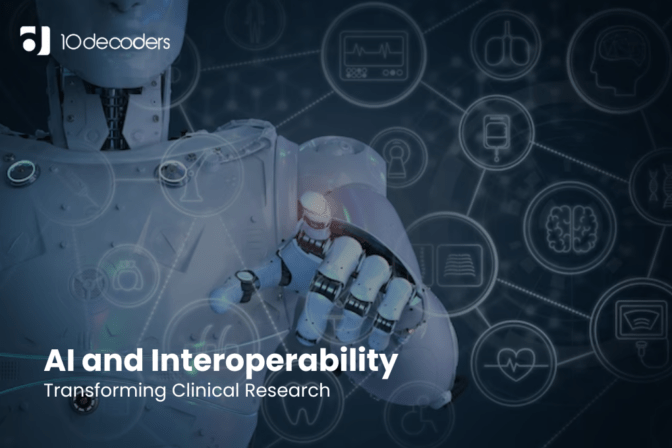AI and Interoperability: Transforming Clinical Research
The clinical research landscape stands at a precipice of transformative change. Artificial intelligence (AI), with its potent blend of computational power and pattern recognition, holds immense promise for accelerating drug development, optimising clinical trials, and unlocking deeper insights into disease mechanisms. However, its power remains largely unrealized, chained by fragmented data silos and the lack of seamless information exchange. Enter interoperability: the ability to integrate and share data across diverse systems, shattering these silos and unleashing the true potential of AI in clinical research. This dynamic synergy between AI and interoperability promises to redefine clinical research, propelling us toward a future of faster, more efficient, and personalised medicine.
Fragmented Landscape: The Bottleneck of Clinical Research
Clinical research currently grapples with a fundamental paradox: a wealth of data locked away in disparate systems and formats. Electronic health records, clinical trial databases, and genomic repositories remain isolated silos, hindering the holistic analysis and knowledge extraction crucial for advancing research. This fragmentation creates significant challenges
- Limited data access: Researchers often lack access to the complete picture of a patient’s journey or a disease’s progression, hindering their ability to identify patterns and develop effective interventions.
- Disparate data formats: Incompatible data formats across different systems render comprehensive analysis difficult, requiring time-consuming and error-prone data harmonisation efforts.
- Slower research progress: Siloed data hampers collaboration and slows the identification of promising drug candidates and treatment strategies.
Interoperability: Breaking Down the Walls
Interoperability offers the key to unlocking the vast potential of clinical research data. It acts as a bridge, connecting these isolated islands of information and enabling seamless data exchange
- Standardised data formats: Initiatives like CDISC and Common Data Elements (CDEs) are establishing harmonised data formats, facilitating seamless integration across different systems.
- Open data platforms: Secure cloud-based platforms allow authorised researchers to access and analyse data from diverse sources, fostering collaboration and knowledge sharing.
- Data governance frameworks: Robust data governance frameworks ensure data privacy and security while enabling responsible data sharing and reuse.
AI and Interoperability: A Powerful Synergy
When paired with interoperable data, AI becomes a transformative force
- Advanced analytics: AI algorithms can analyse massive datasets from disparate sources, identifying hidden patterns and correlations that elude traditional analysis methods. This can lead to breakthroughs in disease diagnosis, drug discovery, and personalised medicine.
- Predictive modelling: AI can build predictive models to anticipate disease progression, treatment efficacy, and potential adverse events, enabling proactive interventions and personalised care plans.
- Virtual trials and simulations: Interoperable data enables the development of virtual trial platforms, where data from previous trials and real-world sources can be used to simulate new trials and optimise study designs.
Challenges and Opportunities on the Horizon
Despite the immense potential, significant challenges remain
- Legacy systems and infrastructure: Upgrading outdated infrastructure and data models to be interoperable can be costly and time-consuming.
- Data privacy and security: Robust data governance frameworks and stringent security measures are crucial to ensure patient privacy and build trust in data-driven initiatives.
- Regulatory hurdles: Integrating real-world data and AI analytics into regulatory decision-making requires ongoing dialogue and collaboration between the industry, academia, and regulatory agencies.
Overcoming these challenges requires a concerted effort from all stakeholders
- Public-private partnerships: Collaboration between governments, academic institutions, and pharmaceutical companies can drive investment in interoperable data infrastructure and AI research.
- Standardisation and harmonisation: Continued efforts towards standardised data formats and regulatory frameworks are crucial for fostering seamless data exchange across borders and systems.
- Education and training: Training a new generation of data scientists and healthcare professionals equipped to leverage AI and interoperable data is essential for realising the full potential of this revolution.
Conclusion: Towards a Data-Driven Future of Healthcare
The synergy between AI and interoperable data presents a unique opportunity to reshape clinical research, accelerating drug development, optimising clinical trials, and fostering personalised medicine. By addressing the challenges and embracing collaboration, we can unlock the hidden potential of this data-driven revolution, ushering in a future where every patient benefits from the collective wisdom of healthcare. This future promises faster cures, more effective treatments, and a new era of personalised healthcare, where the right care reaches the right patient at the right time. The path forward requires both vision and action, but the potential rewards are too vast to ignore. Let us leverage the power of AI and interoperability to bridge the divides, unlock the secrets hidden within, and transform clinical research for the betterment of human health.



